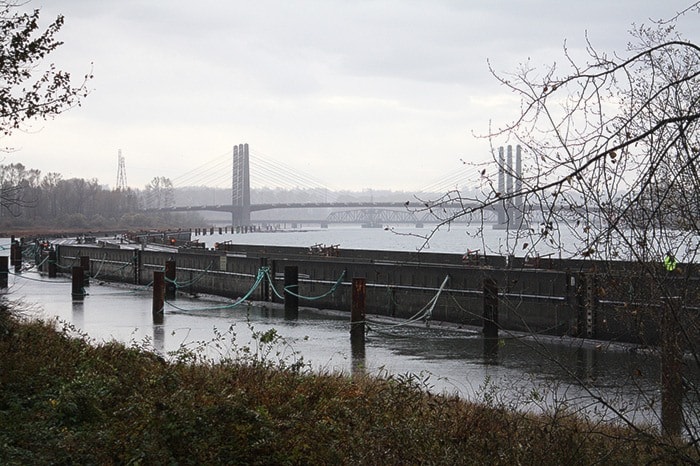The remnants of the world’s longest floating bridge in Seattle, Wa., are tied up in the Pitt River and looking for a buyer.
The concrete floats measure about 110 metres long with 25-centimetre thick walls and formed the floating foundation for a four-lane bridge that crossed Lake Washington.
The 50-year-old structure, known as the State Route 520 bridge, was dismantled this year. It was replaced by a new six-lane floating bridge.
“They are temporarily being stored and are for sale or lease for infrastructure projects,” said Wayne Hamilton, with TrueNorth Operations, which is selling the pontoons.
The pontoons follow the river bank, parallel to Reichenbach Road, up to the Pitt Meadows Marina and tied up at the Harken Towing storage area.
The bridge had 31 pontoons which were acquired by True North Operations Group. The pontoons can be used as temporary or permanent docks or off-loading facilities, piers, for for offshore storage or vessel berthing anywhere in the world.
Not all of the pontoons have been moved to the Pitt River because some have been sold already.
The pontoons were originally built by the Washington State Department of Transport.
“There are markets all over the world. So there are markets in Africa, South Africa, Indonesia, South America,” Hamilton said.
How long it will take to sell the pontoons, remains to be seen.
“From a business point of view, we’re hoping the sooner the better,” Hamilton said.
“They’re in excellent condition, they really are.”

The Alouette River Management Society has questions, though.
ARMS president Ken Stewart learned of the pontoons last week.
“We’re trying to find out a little more,” he said.
He didn’t see any cause for concern, providing nothing was leaching from them.
Former ARMS president Geoff Clayton wanted to know about the approval or permitting process required to move the pontoons. He also wanted to know if the pontoons were bringing any pollutants or invasive species.
But Hamilton pointed out Washington state environmental standards are strict and the pontoons are moving to a similar marine environment in the Pitt River.
When similar structures were moved to Australia, authorities there required cleaning and inspection, he added.
Clayton was also concerned about the pontoons being located so close to the Alouette River estuary.
Pitt Meadows Mayor John Becker was unaware of the pontoons being stored in the river, while Coun. Dave Murray only learned of them a few days ago.
According to a blog from the Washington State Department of Transportation, which describes the bridge dismantling project, the 50-year-old bridge is “structurally vulnerable.
“Severe side winds and strong waves could twist and heave the old pontoons to the point where they crack, break free and sink,” it said in an Oct. 3 post describing the pontoons in their location on Lake Washington.
Other environmental issues have been found to meet public health standards in Seattle and King County.
Ryan Grevill, manager of the navigation protection program with Transport Canada, said the department would only require notice if the pontoons were to be installed permanently. However, the pontoons are now in a designated barge moorage area. That’s where such structures are allowed to be.
Transport Canada will only get involved if they interfere with navigation or cause a hazard.
“As of now, they’re not,” Grevill said.
As for environmental issues, “because they’re not vessels, there’s no requirement for any type of inspection.”
He said the Vancouver Fraser Port Authority was aware of the structures. The authority issued a permit this June to Harken Towing to relocate the moorage piles in that area farther from shore.
Gail Wallin, executive-director with Invasive Species Council of B.C., said there’s a risk that the structures could bring in invasive plants. But most of the laws pertaining to that are provincial rather than federal.
“Good practices by all people is making sure your equipment is clean before you’re moving it,” she said.
“There should have been a focus on making sure it was clean before it came to B.C.”
According to Fisheries and Oceans Canada, invasive species have been entering Canadian waters for centuries and establishing themselves in the local environment.
Shipping lanes, with invasive species carried on ships’ hulls or in ballast water, are considered the largest single source. Ballast water is used in ships’ hulls to balance the weight distribution of a ship.
Recreational and commercial boating can also be a pathway for invasive species, says a brief by the Canadian Council of Fisheries and Aquaculture Ministers Aquatic Invasive Species Task Group. However, the Transport Canada guidelines that are currently in place are only voluntary.
